CURING CHESTNUTS, AND MORE
Gathering
“There’s many a slip ‘twixt the cup and the lip.” Likewise for chestnuts, in this case twixt the ripening of the nuts (in September and October and the lip. That is, if you want the highest quality nuts.
We can start right when the nuts begin to drop. They’ll do so still enclosed in their spiny burs or the burs will open to release the nuts. Don’t be disappointed with burs pretty much empty, perhaps containing a couple or more small, slivers of nuts; these are the result of inadequate pollination.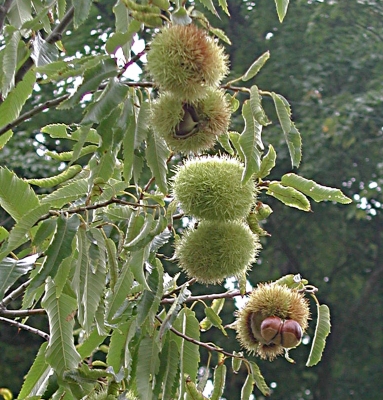
Those disappointing burs are among the first to drop. The real show yields burs bursting with two, even three fat, mahogany brown chestnuts. For the best quality nuts, I gather them daily, at the most every other day, before deer, squirrels, turkeys, and other creatures get at them. For burs on the ground that haven’t yet opened, I just roll my boot over them and pick out the nuts.
Speaking of boots, wear them. And leather gloves. And a hat. Those burs are viciously thorny!
Gathering chestnuts is definitely stoop labor. I’ve read that a Nut Wizard, one of which I own, can be used for harvesting while standing. I’ve found that with the ground strewn with full burs, empty burs, and free nuts, it’s easier to just bend down and pick up only nuts. Then again, I have only three trees.
I’ve heard of some chestnut growers picking the burs from the branches just as they open barely enough to let the nuts peck out. Any plump nuts that are not chestnut brown in color should eventually color up.
Where’s the Weevil?
Another reason for diligent and frequent harvesting is to lesson damage from the chestnut weevil. This insect lays eggs in the burs and nuts towards the end of summer. Larvae grow within, and once nuts are on the ground, bore and exit a hole in the nut. then mosey on to burrow in the ground.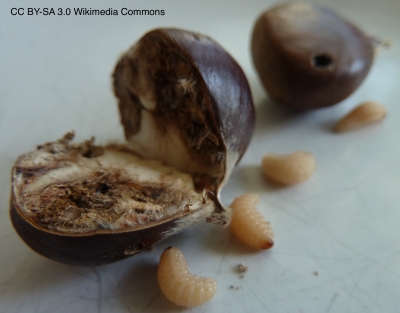
For many years, I used a heat treatment — 20 minutes in 120° F. water, maintained with a sous vide heater — to kill weevils resident in nuts. This year I said to myself “Maybe there aren’t that many weevils lurking,” and dispensed with the treatment.
Only a couple of nuts have had telltale weevil exit holes. More telling, a bowl of chestnuts remained a bowl of chestnuts after a couple of weeks. If infested with weevils, those nuts would be sitting on a bed of squirming, white weevil larvae. Any year or just this year?
The Cure
Chestnuts need to be cured for best eating quality. In contrast to most other nuts, they are high in starch and moisture. Holding off eating the nuts and letting them sit for a couple of weeks lets some of those starches change to sugars. Refrigerator temperatures are good if maintained for at least two weeks.
Curing is faster at room temperature. Problem is that all the moisture within that shell provides fertile ground for attack by fungi and bacteria. So you’ve got to maintain little enough moisture to promote these invaders but not so little that the nutmeats dry out without curing.
Actually, drying is another way to preserve them, and doing so preserves them much, much longer than the two or three months possible for fresh nuts. Once dry, nutmeats are rock hard, but can be ground into a flour for baking — chestnut bread, for example, à la cornbread. Or rehydrated to add to all sorts of dishes.
Another way to keep the nuts for long term storage is to freeze them, shelled and either cooked or uncooked. What we do is roast more chestnuts than we want too eat at a sitting, then freeze the excess, shelled ones.
Good Eating
Although I’ll sometimes nibble on a raw chestnut, which, to me, is reminiscent in texture and flavor of coconut, we generally cook them. One way is to simmer them for about 30 minutes. The result is creamy nutmeats that are easier to peel. Well, not that easy because you have to do it while they’re still hot. The web is crawling with suggestions, such as holding the hot nut with pliers or using the pliers to squeeze out the nutmeat. Still not quick or easy, in my experience.
My favorite way to cook and eat chestnuts is also the most obvious: roasting. More than once having an unslit chestnut sneak its way into the roasting pan and loudly explode in the oven firmly hit home the need to slit before roasting. This lets out enough steam to prevent explosion but keeps in enough to cook the nuts.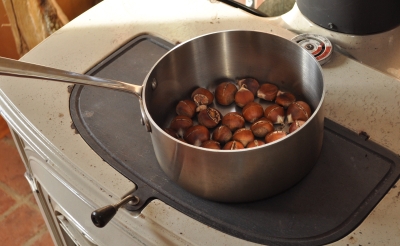
Do it with a knife, as I used to see chestnut peddlers do it on the streets of New York. Quicker and better, in my opinion, is a “chestnut peeler” I bought online that cuts an X into the nut, deep enough to penetrate the skin but not so deep as to quarter the nut.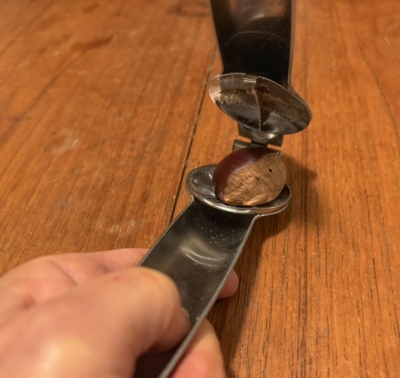
After harvesting, curing, and scoring, my chestnuts go into a 450° oven for about 20 minutes for roasting. Of course, they also could go into a pan for the traditional “roasting on an open fire.” They’re ready for eating when shells have spread to reveal the lightly browned nutmeats within —- unless you fail to slit them.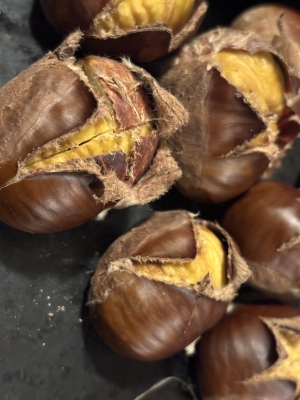


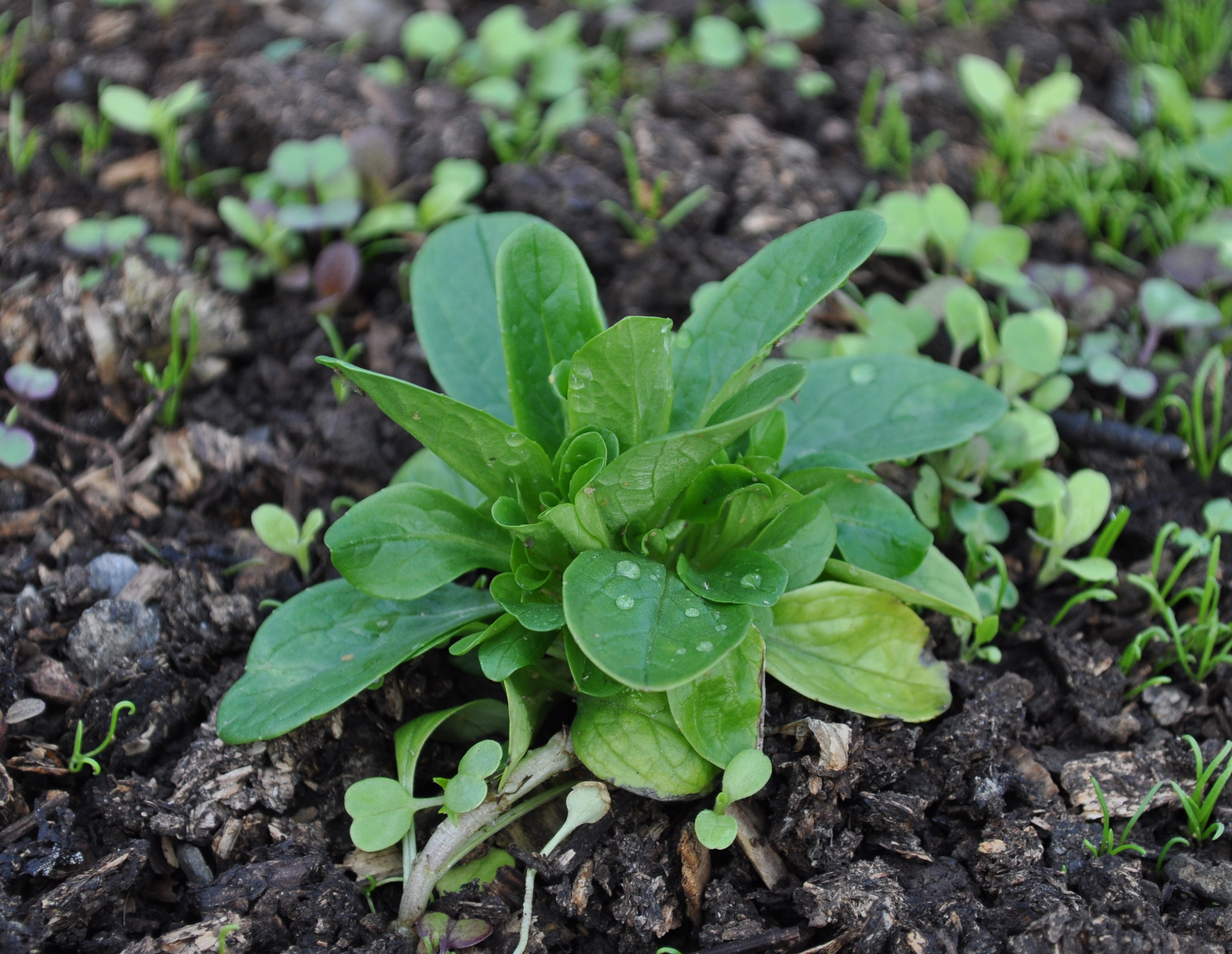

thank you Lee, I go past on Spring town occasionally, cleas there once, and am taking article as a sign to scope out nuts at a place who’s owner then offered thwm via little cardboard sign near by, hope i see someone as generous., ed